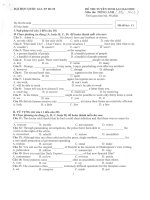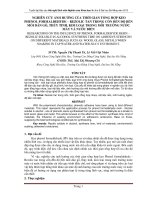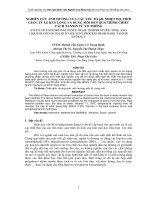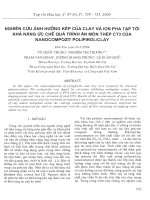báo cáo slide tiếng anh
Bạn đang xem bản rút gọn của tài liệu. Xem và tải ngay bản đầy đủ của tài liệu tại đây (1.44 MB, 24 trang )
Le Thi Van Thu
Advisor: Prof. Oh Won-Keun Ph.D
Department of Pharmacy,
Graduate School of Chosun University
October, 2009
Thesis for Master Degree
Metabolic syndrome
WHO definition of the metabolic syndrome, 1999
Glucose intolerance or diabetes mellitus and/or insulin resistance together with two or
more of the other components listed below:
•
Impaired glucose regulation or diabetes;
•
Insulin resistance
•
Raised arterial pressure ≥ 140/90 mmHg;
•
Raised plasma triglycerides and/or low HDL-cholesterol
•
Central obesity
•
Microalbuminuria
Consequences of the syndrome
Cardiovascular disease, hypertension and chronic renal disease
Diabetes and obesity
1.1 billion adults worldwide are overweight
312 million are obese
Modern diet
Sedentary lifestyle
resulted in an increase in obesity, type 2 diabetes,metabolic
disorders
“exercise in a pill” – AMPK activators
AMP activated protein kinase:
a target for total metabolic control
Structure and regulation of AMPK
Acyl CoA carboxylase and fat metabolism
Myristica fragrans
Family : Myristicaceae
Common name: nutmeg
Constituents: lignans,
essential oil
Biological activity:
anti-oxidant,
anti-inflammatory,
anticariogenic,
hepatoprotective activities.
PTP1B inhibitory effect.
Uses: spice, cosmetic,
drugs.
Part used: seed
Cell culture and AMPK assay by Western blot analysis
HPLC analysis of active compounds and myristicin under
different extraction conditions
Extraction and isolation of active compounds on AMPK
from Myristica fragrans
Processing procedures for reducing myristicin contents
from extracts of Myristica fragrans
Animal experiments
M. Fragrans (seeds, 3 kg)
Ethanol extract
Extracted with 30% EtOH
(30 L × 2, 1 week)
OP-CC (10 × 60 cm) , HP-20
Mob. Phase: EtOH:H
2
O
60% EtOH
80% EtOH
90% EtOH
100% EtOH
Aceton
60:40
80:20 90:10 100:0 Acetone
F1
F2
F3
F5
F4
OP-CC (6 × 60 cm), Silica gel (63 - 200 µm)
Sol. System: n-Hexan: Aceton (6:1 - 0:1)
Compound 6 (12 mg)
Compound 7 (8.5 mg)
Compound 1
(370 mg)
Compound 2 (28.9 mg)
Compound 3 (12.7 mg)
Compound 4 (6.7 mg)
Compound 5 (7.8 mg)
OP-CC (5 × 60 cm)
RP ODS-A (12 nm)
MeOH: H
2
O
1.5:1 to 2:1
OP-CC (5 × 60 cm)
RP ODS-A (12 nm)
MeOH: H
2
O
2:1 to 5:1
Gilson HPLC
RP-C18 (10 × 250 mm, 10 µm)
Mob. Phase: MeOH/H
2
O + 0.1% Formic acid
Isocratic: 60/40
Structure determination of tetrahydrofuran type-lignans from
Myristica fragrans
1
H-NMR
13
C-NMR
Compound 1
Structure determination of tetrahydrofuran type-lignans from
Myristica fragrans
1
H-NMR
13
C-NMR
Compound 2
Structure determination of tetrahydrofuran type-lignans from
Myristica fragrans
1
H-NMR
13
C-NMR
Compound 3
Structure determination of tetrahydrofuran type-lignans from
Myristica fragrans
1
H-NMR
13
C-NMR
Compound 4
Structure determination of tetrahydrofuran type-lignans from
Myristica fragrans
1
H-NMR
13
C-NMR
Compound 5
Structure determination of tetrahydrofuran type-lignans from
Myristica fragrans
1
H-NMR
13
C-NMR
Compound 6
Structure determination of tetrahydrofuran type-lignans from
Myristica fragrans
1
H-NMR
13
C-NMR
Compound 7
O
HO
R
1
R
2
OR
4
R
3
O
HO
MeO
OH
OMe
O
O
HO
MeO
OH
OMe
O
HO
MeO
OH
OMe
O
OO
O
4 R
1
= R
3
= OMe, R
2
= R
4
= H
5 R
1
= R
3
= OMe, R
2
= H, R
4
= Me
6 R
1
= R
2
= R
3
= OMe, R
4
= H
1
3
2
7
2
3 4
5
1'
2'
4'
5'
6'
3'
1''
2''
3''
4''
5''
6''
Fig. 3. Chemical structures of compounds 1–7 isolated from Myristica fragrans
Processing procedures for reducing myristicin contents from
extracts of Myristica fragrans
M. Fragrans (seeds, 3 kg)
Ethanol extract
Extracted with 30% EtOH
(30 L × 2, 1 week)
OP-CC (10 × 60 cm)
HP-20
Mob. Phase: EtOH:H
2
O
60% EtOH
80% EtOH
90% EtOH
100% EtOH
Aceton
60:40
80:20 90:10 100:0 Acetone
Processing procedures for reducing myristicin contents from
extracts of Myristica fragrans
Step 1
0
50
100
% M obile Phase
0
5000
10000
15000
20000
mV olts
0 10 20 30 40 50 60
Minutes
Zero
c:\gilson\test\test-1.009\test-1.gdt : uv1 : Step 1: Inj. Number: 1
c:\gilson\test\test-1.009\test-1.gdt : uv2 : Step 1: Inj. Number: 1
pump a
pump b
3
1
2
4
5
6
7
Fig. 18. A representative HPLC profile of some major lignans (1–6) and myristicin from
the total MeOH extract of Myristica fragrans with detections at 205 and 280 nm. Key to
peak identity: (1) macelignan, (2) meso-dihydroguaiaretic acid, (3) (±)-trans-
dehydrodiisoeugenol, (4) nectandrin B, (5) licarin A, (6) otobaphenol, and (7) myristicin.
Chromatographic method used: 0-40 min (50-70% MeOH), 40-52 min (70-100% MeOH),
52-60 min (100% MeOH).
Processing procedures for reducing myristicin contents from
extracts of Myristica fragrans
Step 3
0
50
100
% M o b i le P h a se
0
100 0
200 0
300 0
m V o lt s
0 20 40 60
Minutes
c:\gilson\test\test-2.006\test-2.gdt : uv1 : Step 3: Inj. Number: 3
c:\gilson\test\test-2.006\test-2.gdt : uv2 : Step 3: Inj. Number: 3
pump a
pump b
1
4
2,3
6
5
7
Fig. 19. A representative HPLC profile of isolated lignans 1−7 from the 80%
EtOH fraction of the 30% EtOH-soluble extract of Myristica fragrans with
detections at 205 and 280 nm. Key to peak identity: (1) tetrahydrofuroguaiacin B,
(2) saucernetindiol, (3) verrucosin, (4) nectandrin B, (5) nectandrin A, (6)
fragransin C1, and (7) galbacin. (For chromatographic protocol see Experimental
and Methods).
Compounds
Fractions
Water
10%
EtOH
20%
EtOH
30%
EtOH
40%
EtOH
50%
EtOH
75%
EtOH
75%
MeOH
nectandrin B 0.62% 0.94% 2.98% 8.69% 1.95% 2.77% 2.95% 7.47%
myristicin 0.19% 0.31% 0.33% 0.51% 1.34% 1.48% 1.27% 1.80%
Compounds
Fractions
80% EtOH 90% EtOH 100% EtOH 100% Acetone
nectandrin B 26.01% 61.02% 14.52% ─
meso-dihydro
guaiaretic acid
─ 2.99% 62.49% 13.78%
macelignans ─ ─ ─ 16.57%
myristicin ─ 0.61% 3.61% 21.66%
Table 4. Contents of nectandrin B and myristicin in each solvent
fraction from 30% EtOH-soluble extract of M. fragrans
Table 3. Contents of nectandrin B and myristicin in each solvent
extract of M. fragrans
Effect of tetrahydrofuran type-lignans from Myristica fragrans
on AMPK activation
Fig. 20. Stimulatory effects of isolated lignans 1−7 on AMP-activated protein
kinase (AMPK) activity. (A) The stimulatory effects of isolated compounds 1−7
on AMPK activity at the concentration of 20 μg/mL. (B) The stimulatory effects of
isolated compounds 1−7 on AMPK activity at the concentration of 5 μg/mL.
Animal experiment
Table 5. Characterization of ND mice as control with normal diet, and HFD
mice treated with or without THF for six weeks.
Blood chemistry
ND HFD HFD + THF
(n = 10) (n = 10) (n = 10)
GPT 48.14 ± 15.22 81.84 ± 67.63 68.06 ± 56.29
BUN 25.93 ± 3.09 23.89 ± 1.77 22.74 ± 1.89
GLUC 159.33 ± 28.44 232.7 ± 23.39* 199.10 ± 29.89**
CHOL 115.73 ± 17.16 170.91 ± 15.35* 153.46 ± 22.06
HDLC 90.64 ± 14.52 125.48 ± 5.40* 125.98 ± 12.39
LDLC 22.78 ± 2.54 32.20 ± 3.97* 25.90 ± 2.47**
TRIG 99 ± 15.64 88.40 ± 14.83 79.70 ± 9.88
Kidney weight (g) 0.29 ± 0.03 0.31 ± 0.02 0.29 ± 0.02***
Liver weight (g) 1.04 ± 0.10 1.01 ± 0.08 0.95 ± 0.12***
Epididymis fat (g) 0.46 ± 0.06 1.74 ± 0.53 1.24 ± 0.40**
Food intake (g/day) 2.71 ± 0.08 2.24 ± 0.05 2.20 ± 0.07***
Animal experiment
AMPK - a therapeutic target for the treatment of metabolic syndrome
seven 2,5-bis-aryl-3,4-dimethyltetrahydrofuran lignans were isolated
tetrahydrofuroguaiacin B (1),
saucernetindiol (2),
verrucosin (3),
nectandrin B (4),
nectandrin A (5),
fragransin C
1
(6)
galbacin (7)
As AMPK activators
Tetrahydrofuran mixture exert anti-obesity effect in C57BL/6 models
Processing procedure to prepare a myristicin-free, lignan enriched fraction
was established.









